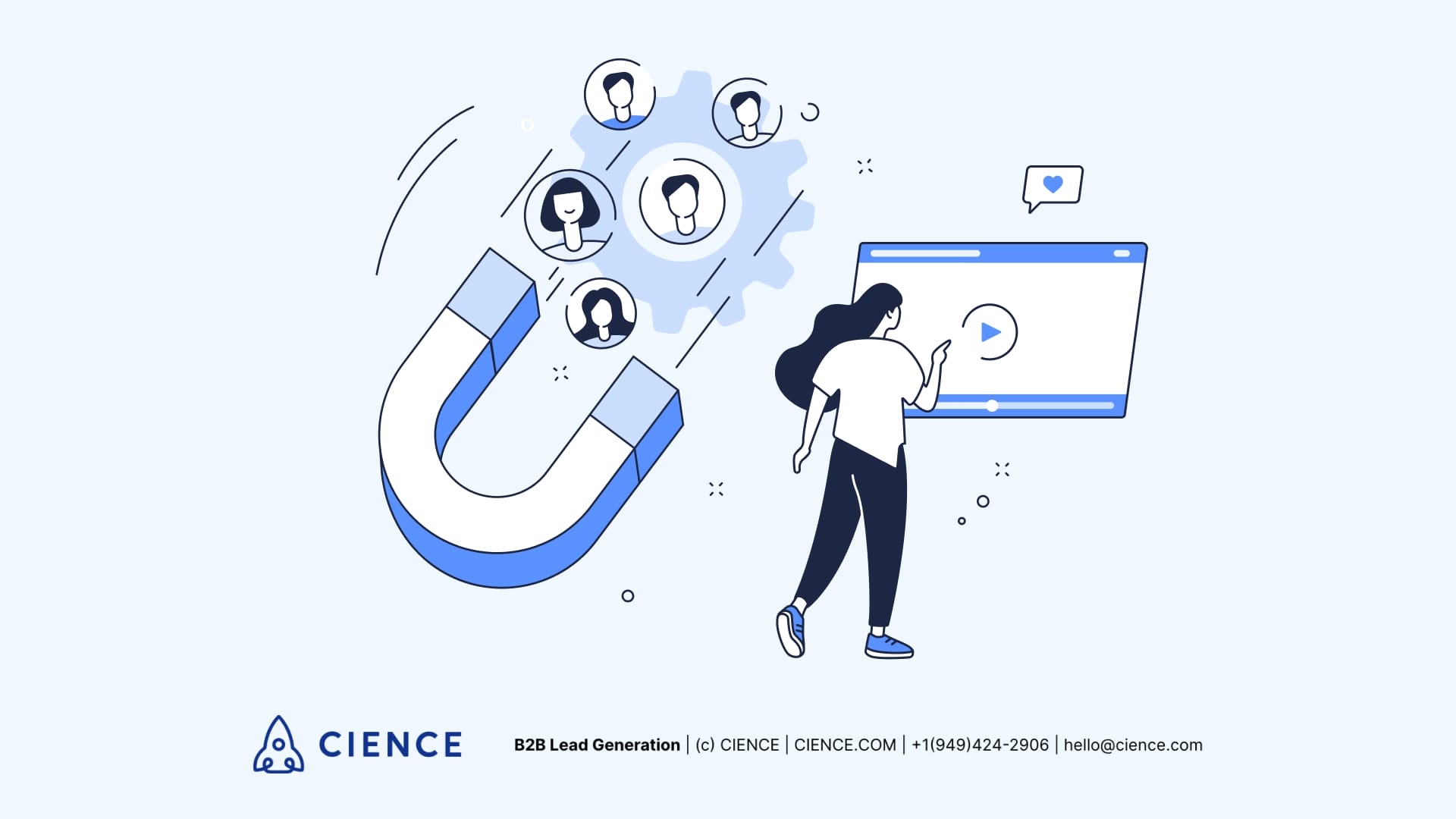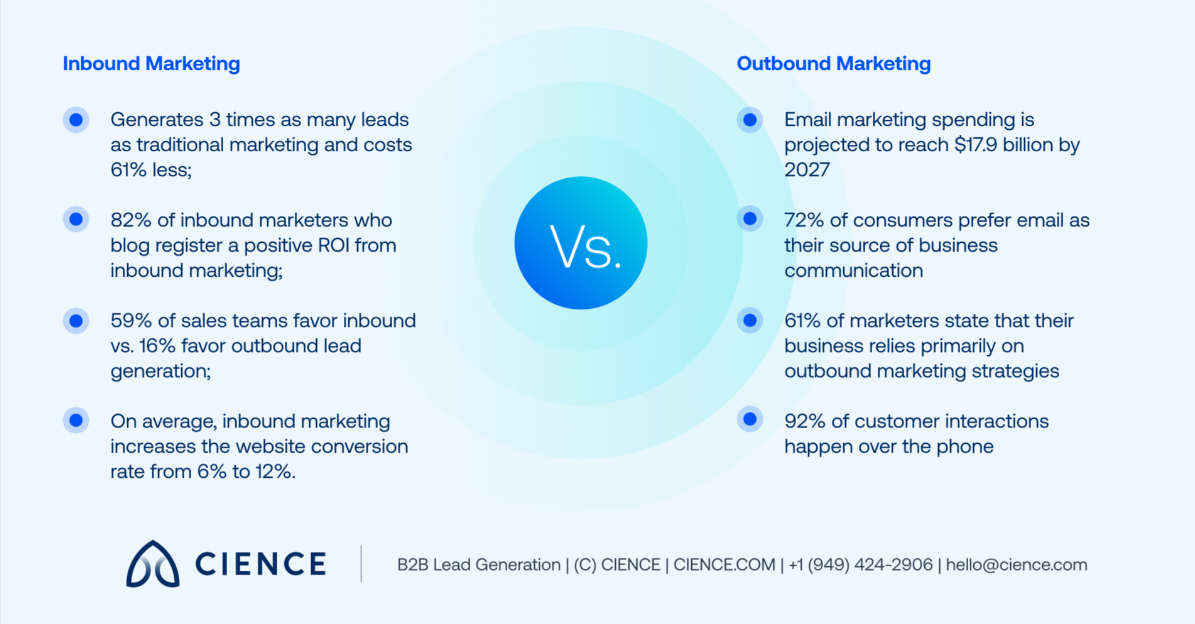Inbound vs. Outbound Marketing: What Works Better for Your Business?
Outbound versus inbound—the long-lasting battle between these two camps of marketers has been around since the 2000s. During these years, outbound has been compared with inbound marketing for B2B companies backward and forward. Nevertheless, specialists still argue which one is more effective when it comes to planning marketing strategies and budget distribution for the next quartile: Is it better to apply both methodologies? How do they differ from each other? Why do outbound channels still bring results? And most importantly, can inbound and outbound be aligned to support and strengthen each other?
In this article, CIENCE answers these burning questions and many more. Over the past six years serving more than 1,500 clients, we’ve become a trusted expert in running outbound marketing campaigns. Furthermore, we’ve gained experience in projects that successfully combine these two approaches, and we are happy to share them with our readers.
Definitions of Inbound and Outbound Marketing
Before going into the details about the outbound-inbound differences, it is vital to define what these two concepts stand for:
What is inbound marketing?
Inbound marketing is a strategy based on attracting potential customers through creating engaging and relevant content that addresses prospect’s interests and needs. This approach presupposes using exclusively unintrusive techniques for attracting new clients and full assistance of the prospect from the brand discovery stage to brand loyalty. Inbound is considered to be a passive type of marketing, where the first contact happens externally—from the client to the company.

Weighing the Benefits and Drawbacks of Inbound Marketing
Benefits:
- Contextual Engagement: Inbound marketing meets prospects where they are in their buyer's journey, offering relevant content that addresses their specific needs and pain points.
- Cost-effective: Inbound marketing typically costs 61% less per lead than outbound marketing strategy.
- Brand Awareness and Trust: Businesses that blog are 13 times more likely to achieve a positive ROI for their efforts than those that do not and have 97% more inbound links, which improves SEO and brand visibility
- Multi-Channel Strategy: Inbound marketing encourages the use of various channels such as blogs, social media, email marketing, and SEO. This approach has proven to increase conversion rates by 24%.
Drawbacks:
- Slow results: It can take 6-12 months to see significant results from inbound marketing efforts
- Resource Intensive: Effective inbound marketing requires a substantial investment of time and resources.
- High Competition: The digital space is highly competitive, making it difficult for content to stand out.
- Dependency on Algorithms: Inbound marketing success is heavily reliant on search engine and social media algorithms. Changes in these algorithms can significantly impact traffic and lead generation efforts.
CIENCE's Success with Inbound Marketing: Case Study
CIENCE effectively integrated content creation, SEO, social media, and lead nurturing to attract and convert high-quality leads. By producing tailored content addressing specific client pain points, CIENCE achieved a significant increase in lead generation and conversion rates. Key results include a 50% rise in lead volume and a 35% improvement in conversion rates, demonstrating the power of a well-executed inbound marketing strategy.
"I think it is the level of their service; they really provide very good services,” said Eilam Osri.
💡 Read the full case study.
Check Out Our Inbound Expertise
What is Outbound Marketing?
Outbound marketing is a strategy that presumes direct and immediate contact with prospects by channeling the messages outward. This is an active method of attracting potential clients, where a salesperson establishes the first contact with a potential customer who fits the ideal customer profile of the company through such channels as cold calling, cold emails, paid ads, targeted landing pages, etc. The key feature of outbound marketing is that to be successful, the campaign has to be well-researched and highly personalized.

Weighing the Benefits and Drawbacks of Outbound Marketing
Benefits:
- Immediate Results: Outbound marketing strategies, such as cold calling and direct mail, can generate immediate responses and quick results.
- Controlled Targeting: Outbound marketing allows for precise targeting of specific accounts and decision-makers, ensuring that marketing efforts are directed at the most relevant prospects.
- Easier to Measure ROI: Companies using outbound marketing report higher confidence in measuring their ROI compared to inbound
- Enhanced Personalization: Outbound marketing can be highly personalized, creating tailored messages that resonate deeply with the target audience, leading to better engagement.
- Omni-Channel Strategy: Multi-channel outbound campaigns can increase engagement rates by up to 300% compared to single-channel efforts.
Drawbacks:
- High Costs: The cost per lead for outbound marketing can be significantly higher, often exceeding the cost of inbound leads by more than double
- Interruptive Nature: Outbound marketing strategies are often seen as interruptive and can be perceived negatively by potential customers. This can lead to a lower response rate and potential damage to the brand's reputation.
- Resistance to Messages: Many people have developed resistance to outbound marketing messages, using tools like ad blockers and spam filters to avoid them.
- Short-Term Focus: Companies focusing solely on outbound marketing without integrating inbound strategies often see lower long-term customer retention rates
Strategic Outbound Approach: CIENCE Case Study
CIENCE successfully helped a digital reputation management agency, achieve its growth goals by implementing a multi-channel outbound marketing strategy. The campaign used phone, email, LinkedIn, ads, and a landing page, with a 25% email open rate and nearly 10% phone conversation rate. The multi-channel approach increased engagement by up to 300% compared to single-channel efforts.
“CIENCE has been tasked with outbound lead generation, setting us up appointments, and giving us the opportunity to land sales by eliminating the prospecting work so we can perform other duties. They are essentially our P3 sales team, something we never initially had.” - Jared Hudson
💡 Read the full case study.
Dive into Our Inbound Solutions
Key Differences Between Inbound and Outbound Marketing
Marketers announced the defeat of outbound with the advent of the Internet and opened access to information. Those businesses that have been around long enough still remember how twenty years ago, website content was manipulative (using as many keywords in each sentence as possible), self-absorbed, and pushy (e.g., pop-up windows).
A huge number of websites used exactly this strategy and even received great results. When inbound came by, companies switched from self-absorbed, pushy, and manipulative outbound to gentle, smart, and proactive inbound, associated with the new data-driven techniques of winning the customers.
During the last decade, outbound evolved and adapted to the technology era too. Therefore, the key difference between inbound and outbound marketing in B2B isn’t the usage of advanced technologies but the behavioral model of attracting prospects.
Outbound marketing implies looking for a good-fit company and engaging with them directly, while in inbound you have to create an environment (similar to a spider net) and wait for a good-fit prospect to fall into it. Besides that, outbound provides the opportunity to go after the prospect you want while inbound simply hopes to make them notice your company, product, service while reading your content, and only after that leaping into the sales cycle.
The table below includes a summary of the main differences between inbound and outbound marketing for B2B companies:

To have a more detailed understanding of outbound vs. inbound distinction, let’s expand this table and talk more about the key differences.
1. Time frame and achieved results
Inbound is a long-term team game where each member contributes something that should hypothetically work out in the next half a year. Moreover, the content is slow. It takes time (and money) to understand what’s wrong with an article or the entire blog and why it doesn’t generate leads.
Outbound is very different in this essence. The whole process is operated by a researcher, a copywriter, and a sales development representative (SDR) working in perfect alignment. It is managed by a project manager and controlled by the client’s POC (point of contact). Campaigns are launched in less than two weeks after contracts are signed, and the first results are gained within days or weeks after the start (depending on the campaign, sales cycle longitude, industry, etc.). Outbound is extremely fast and very flexible compared to inbound.
2. ROI and types of communication
Most inbound marketers grudgingly admit that a large part of high-quality content does not attain the key marketing goal—generating hot leads. People come to read the articles rather than buy the company’s products or services. They can create a masterpiece, but that alone does not increase sales.
Despite the fact that there are a large number of inbound marketing tools available (like HubSpot or its alternatives) to track KPIs, inbound ROI is hard to measure. This happens because marketers are moving in the dark and can’t know what impact certain actions they do have on the prospect’s decision to purchase. The ball is in the prospect’s hands, they control the process, and they decide when it’s time to transit from a passive reader of the blog content into an active buyer of the company’s services.
When it comes to the effectiveness of outbound, there is more flexibility in one-on-one conversations between a salesperson and a prospect compared to inbound. SDRs have more space for a quick change of the subject when they feel that the talk is going nowhere. In a sense, sales representatives have control over the conversation and can easily adjust their behavior almost instantly when needed.
SDRs always know their ultimate goal—qualify and pass the prospect further down the funnel. In other words, they have a very defined goal and clear sales development methodologies. This makes ROI easy to calculate: you invest a certain sum of money and get a certain number of appointments with good-fit companies, which results in a certain percentage of closed opportunities.

3. Scaling process
Scaling is a complicated process that requires determination and precision work by the entire team for months. However, outbound marketing helps to achieve your goals easier and faster than with inbound for several reasons:
- Shorter timeline: Because outbound marketing campaigns are faster, you can get an immediate “response” to the chosen strategy and adjust it right away to get better results (e.g., change the subject line of an email, follow up every three days, and make cold calls in the early morning).
- Quick feedback: One-on-one conversations in real-time increase the chances of receiving answers to questions regarding the ways to improve your services.
- More control over the process: In outbound, you are the one in charge, not your audience or Google page-ranking algorithms.
- Hiring more full-time SDR and proportionally increasing the number of prospects: Producing twice as much content doesn’t guarantee better results but enlarging your team does.
4. Outreach channels
Inbound channels to prospects are passive and limited to the Internet space. Outbound strategies, on the other hand, are more active and personal. The most common are:
| Inbound | Outbound |
| Website | Email Marketing |
| Content | Phone Calling |
| SEO | Outreach via Social Networks |
| Social Media Marketing | Landing Pages |
| PR/Content Placement | Targeted Ads |
| Guest Blogging | Account-Based Marketing |
Other tactics strongly associated with outbound are offline activities like tradeshows or traditional media advertising (TV, print, billboard, and direct mail).

Why Is Outbound Still Effective?
Even though a large percentage of marketers ignore outbound, preferring to use exclusively inbound strategies, outbound has proven its effectiveness throughout the decades. Here are a few reasons why outbound is worth your attention:
1. Immediate ROI
In inbound marketing, it is not always clear which traffic leads to sales and how effective it is. The beauty of outbound is that it allows you to not just attract leads but convert them in a fast and efficient way.
2. Efficient targeting
Outbound marketing allows you to get directly in front of your prospect even if they don’t know who you are and what you do. You can choose precisely who you’re pitching your product to. Instead of weeding through hundreds of inbound leads, you’re going after your most-desired accounts. You’re able to choose who you want to reach out to and have full control over the sales process.
3. Faster results
Inbound tactics are effective in the long term, but if you’re looking for quick growth in your customer base, outbound is the right choice. The Bridge Report states that with the rise of content marketing, there has been a decrease in sales. All organizations solely focusing on inbound should consider looking into outbound to complement their efforts.

4. Easier to scale
Companies that want to establish the right tactics to scale growth should adopt outbound strategies. Leveraging outbound sales services by using sales development representatives to pitch to a specific set of accounts leads to incredible results. This is typically done by targeting the ideal customer profile of these accounts. The SDR’s prospecting represents narrowly focused activities performed daily to a wider target audience than any full-cycle representative could handle. As such, the ability to add SDRs and grow the total prospecting population, while still remaining targeted, can be readily achieved.
5. Understanding customer needs
When organizations are choosing between inbound and outbound for B2B, they tend to overlook the personalization messaging benefit of outbound. By directly communicating with your customers, you can learn more about them, and therefore, develop a clear understanding of their problems and solutions to offer. Once you’re on a path of consistent messaging that is relevant to what your prospect cares about, you build trust and a better product. With outbound, you’ll learn more about your target audience within a short period.
6. Quicken the go-to-market process
Inbound takes time. Can you estimate how long it takes to rank on the first page of Google SERP (search engine result page)? Can you prevent other businesses from taking your place in a Google page rank? While inbound strategies can be a strong asset for your business, they require time to bring results. Outbound allows you to get to the market as soon as your campaign is ready.
Finally: Which Strategy to Choose?
Determining the best marketing approach for your business depends on various factors, including your goals, resources, target audience, and the urgency of desired results.
Inbound marketing excels in contexts where the target audience is already familiar with the type of product or service offered. It is particularly effective for B2C markets.
Conversely, outbound marketing can be more effective for B2B marketing, especially for companies looking to launch new products or expand into new markets.

Combining Both Approaches
For many businesses, a hybrid approach that leverages the strengths of both inbound and outbound marketing can be the most effective strategy. Here’s why:
- Complementary Strengths: Outbound can drive immediate traffic and leads, while inbound nurtures them through the sales funnel with valuable content.
- Increased Reach: Combining both strategies ensures a broader reach and multiple touchpoints with potential customers.
- Balanced Investment: Distributing resources between inbound and outbound efforts can optimize budget allocation and ROI.
Need Strategy Help? Try CIENCE
Outbound vs. Inbound—Frenemies?
When making your decision about which strategy to choose—inbound or outbound—for your B2B company, take into account all the factors above. But we at CIENCE believe that these two strategies work better in the alliance.
If you’ve never tried outbound marketing before, it could be exactly what your business is missing. Experiment with the outbound strategies to complement your inbound and see the difference. Inbound alone isn’t enough to succeed in the competition for the prospect’s attention. By creating targeted email campaigns and buyer persona-based outreach, you’ll be able to move through the sales cycle more quickly.
Utilizing outbound marketing is a great way to boost your inbound marketing and increase its effectiveness. Be sure to test different strategies and find what brings better results. The CIENCE team can become an extension of your internal sales team and provide you with the high-quality outbound outreach you desire. Unsure which path to take?
Key Takeways:
Choose Inbound Marketing If:
🔹You have a limited budget and prefer cost-effective strategies.
🔹You aim to build long-term brand authority and a sustainable lead pipeline.
🔹You have the resources to consistently create high-quality content.
Choose Outbound Marketing If:
🔹You need immediate results and quick lead generation.
🔹You have a budget to invest in targeted and potentially expensive campaigns.
🔹You prefer direct and personalized outreach to specific demographics.
Consider a Hybrid Approach If:
🔹You want to maximize reach and effectiveness by leveraging the strengths of both strategies.
🔹You have the resources to manage both inbound content and outbound campaigns.
🔹You aim to create a balanced and comprehensive marketing strategy that drives both immediate and long-term results.
